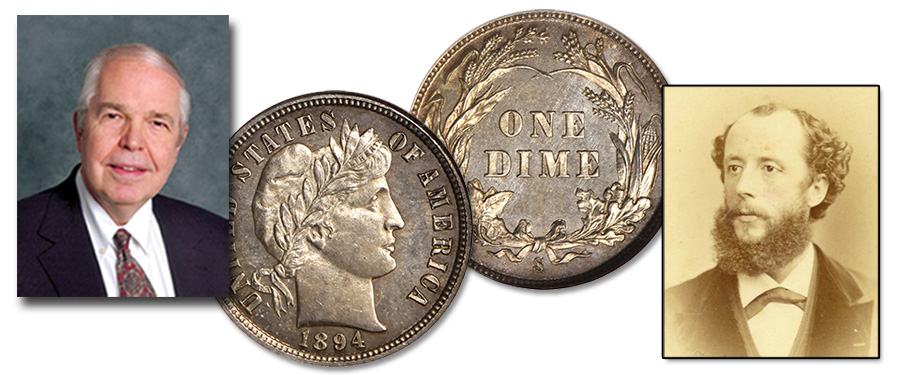
Charles Edward Barber became the sixth engraver at the
Philadelphia Mint in 1880, following the death of his father, Chief Engraver
William Barber; he remained in the post until his death on February 18, 1917. The
Liberty Head silver denominations he designed and which are known as “Barber
coins, were made from 1892 to 1916. Today they are very popular, and the Barber
Coin Collectors Club gathers together specialists in the various issues.
Perhaps the single most famous of his coins is the 1894-S dime, of which only
24 are said to have been struck.
While Charles Barber is best known today for the “Barber”
coins mentioned above, he also designed the 1883 Liberty Head nickel and certain
commemorative coins and medals. Among patterns, certain dies of 1879 are
sometimes ascribed to his hand, but they are not signed, and at present there
is no complete delineation of who did what among the various dies of this year and
others through 1880, although the Flowing Hair $4 Stella and the various
“Washlady” dies are attributed to him. With some exceptions, it is evident
that Charles Barber’s work was second in artistic rank to that of his assistant, George
T. Morgan.
Charles Barber was born in London in 1840, and in 1852 came
to America with his family. His father gained a position with the Philadelphia
Mint and in January 1869, following the death on New Year’s day of James B.
Longacre, became chief engraver. In the best Mint tradition of nepotism, Chief
Engraver Barber signed Charles as an assistant, although it seems likely that
the younger Barber’s talents in this area were modest. In March 1875, Charles
Barber married Martha E. Jones and they had one child, a daughter Edith. Martha
died in 1898, and on December 3, 1902, widower Barber married Caroline
Gaston.
After his father’s death on August 31, 1879, there was an
interregnum in which George T. Morgan was considered for the position of chief
engraver. However, the position passed from father to son, and in early 1880
Charles E. Barber was named to the post. During his tenure he
designed the 1883 Hawaiian silver coinage and certain coins for Cuba and
Venezuela. Among commemorative coin dies he created the obverse of the 1892
Columbian half dollar (from models prepared by Olin Levi Warner), both dies for
the 1893 Isabella quarter (from sketches by Kenyon Cox, of “Brownies” cartoon
fame), the 1900 Lafayette dollar (numismatic historian Arlie Slabaugh has
observed that Barber’s work is virtually certainly a plagiarism of the obverse
of the Yorktown Centennial medal of 1881, engraved by Peter L. Krider), and
others. The complexity of sorting out who did what with certain dies is
illustrated by the obverse for the 1903 Louisiana Purchase Exposition
commemorative gold dollar; Charles Barber is given as the author of the die,
but George T. Morgan assisted, and the portrait was copied from an early
nineteenth century die by Chief Engraver John Reich, who in turn modeled it from
a bust by Houdon.
Not even a brief biography of Barber—such as this is—would
be complete without mentioning his position as the “enemy” in the “private war”
President Theodore Roosevelt waged with the Mint in 1905-1907, when the chief
executive sought to have a non-Mint employee, famous sculptor Augustus
Saint-Gaudens, prepare new designs for all American coins from the cent to the
$20 gold piece. The president he felt that United States coins — in
particular, Barber’s current designs for the silver coins — were insipid. The
story of Roosevelt’s interest, which has been told at length many times in our
catalogs and elsewhere, resulted in the creation of the memorable MCMVII High
Relief $20, over Barber’s strong objections.
Barber’s obituary in The Numismatist, April
1917, noted that “the latest coins designed by the younger Mr. Barber were the
Panama-Pacific $2½ gold and the 50-cent silver pieces. Mr. Barber cut the dies
for a number of the pattern series, and is said to have possessed a splendid
collection of these pieces.”





